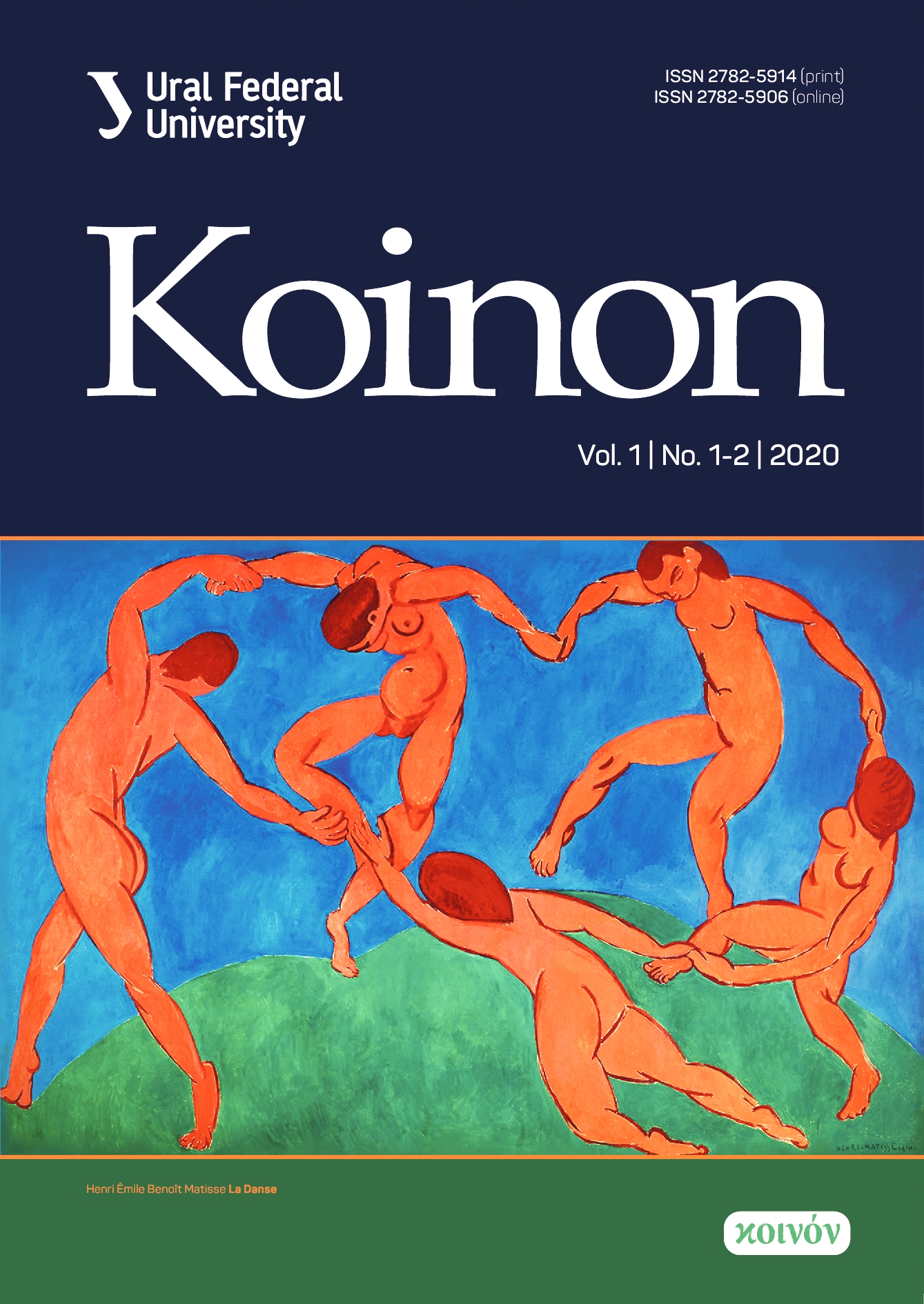ISSN: 2782-5914 (Print)
ISSN: 2782-5906 (Online)

“Arctic Creatures: Repparfjord” (2019), Tine Surel Lange, available at: https://tinesurellange.com/ Arctic-Creatures-Repparfjord (accessed 20 April 2022).
“ARTE_mis” (2017), Maja Smrekar, available at: https://www.majasmrekar.org/k-9-topology-artemis (accessed 20 April 2022).
Bachmann-Medick, D. (2017), Cultural Turns: Neuorientierungen in den Kulturwissenschaften, translated by Tashkenova, S., Novoe literaturnoe obozrenie, Moscow, 504 p. (in Russian).
Bogost, I. (2012), “The New Aesthetic Needs to Get Weirder”, The Atlantic, 13 April, available at: https:// www.theatlantic.com/technology/archive/2012/04/the-new-aesthetic-needs-to-get-weirder/255838/ (accessed 7 April 2022).
Braidotti, R. (2021), The Posthuman, translated by Khamis, D., Izdatel’stvo Instituta Gaidara, Moscow, 408 p. (in Russian).
Chakrabarti, D. (2020), Ob antropotsene [About the Anthropocene], translated by Kralechkin, D., V-A-C Press, Artguide Editions, Moscow, 160 p. (in Russian).
Czakon, T. and Michna, N. A. (2021), “Art Beyond the Anthropocene: A Philosophical Analysis of Selected Examples of Post-Anthropocentric Art in the Context of Ecological Change”, Journal of Asia-Pacific Pop Culture, vol. 6, no. 2, pp. 245–261. DOI: 10.5325/jasiapacipopcult.6.2.0245.
“Dark Ecology (Seoul)” (2015), Hayden Fowler, available at: http://haydenfowler.net/projects/darkecology-seoul.html (accessed 20 April 2022).
Davis, H. and Turpin, E. (2015), “Art & Death: Lives Between the Fifth Assessment & the Sixth Extinction”, in Davis, H. and Turpin, E. (eds.), Art in Antropocene: Encounters Among Aesthetics, Politics, Environments and Epistemologies, Open Humanity Press, London, pp. 3–29.
“Desert Creatures: The Salton Sea” (2019), Tine Surel Lange, available at: https://tinesurellange.com/ Desert-Creatures-The-Salton-Sea (accessed 20 April 2022).
“Ear on Arm. Engineering Internet Organ” (2022), Stelarc, available at: http://stelarc.org/?catID=20242 (accessed 20 April 2022).
Eliasson, O. and Rosing, M. (2018), Ice Watch, available at: https://icewatch.london/ (accessed 20 April 2022).
Ferrando, F. (2013), “Posthumanism, Transhumanism, Antihumanism, Metahumanism, and New Materialisms Differences and Relations”, Existenz, vol. 8, no. 2, available at: https://existenz.us/ volumes/Vol.8-2Ferrando.html (accessed 7 April 2022).
Ferrando, F. (2016), “The Party of the Anthropocene: Post-humanism, Environmentalism and the Postanthropocentric Paradigm Shift”, Relations. Beyond Anthropocentrism, vol. 4, no. 2, pp. 159–173. DOI: 10.7358/rela-2016-002-ferr.
Ferrando, F. (2022), Philosophical Posthumanism, translated by Kralechkin, D., Higher School of Economics, Moscow, 360 p. (in Russian).
Haraway, D. J. (2017), A Cyborg Manifesto: Science, Technology, and Socialist-Feminism in the Late Twentieth Century, translated by Garadzha, A. V., Ad Marginem, Garage Museum of Contemporary Art, Moscow, 128 p. (in Russia).
Haraway, D. J. (2020), Stayng with the Trouble: Making Kin in the Chthulucene, translated by Pisarev, A. A., Khamis, D. Ya. and Khanova, P. A., Gile Press, Perm, 340 p. (in Russian).
“HYDRA. New media art in the context of eco-anxiety” (2022), Sevkabel’ port, available at: https:// sevcableport.ru/ru/culture/hydra (accessed 20 April 2022) (in Russian).
“Jeg er mangfoldig” (2020), Viktor Pedersen, available at: https://www.viktorpedersen.com/jeg-ermangfoldig (accessed 20 April 2022).
Kordic, A., Godward, F. and Martinique, E. (2016), “Posthumanism and Contemporary Art”, Widewalls, 7 October, available at: https://www.widewalls.ch/magazine/posthumanism-contemporary-art (accessed 7 April 2022).
Mirzoeff, N. (2019), How to See the World, translated by Johansson, G. D., Ad Marginem Press, Garage Museum of Contemporary Art, Moscow, 344 p. (in Russian).
Morton, T. (2019), Hyperobjects: Philosophy and Ecology after the End of the World, translated by Abramenko, V. I., Gile Press, Perm, 284 p. (in Russian).
“Nuclear Creatures: West Lake Landfill” (2019), Tine Surel Lange, available at: https://tinesurellange. com/Nuclear-Creatures-West-Lake-Landfill (accessed 20 April 2022).
“ORLAN: Strip-Tease, Youy Sur Ma Vie, Tout Sur Mon Art” (2021), ORLAN, offi cial website, 16 December, available at: http://www.orlan.eu/works/videos-dorlan-2/ (accessed 20 April 2022).
Reiss, J. (ed.) (2016), Art, Theory and Practice in the Anthropocene, Vernon Press, 2016, 173 p.
Susen, S. (2021), “Reflections on the (Post-)Human Condition: Towards New Forms of Engagement with the World?”, Social Epistemology, vol. 36, no. 11, pp. 63–94. DOI 10.1080/02691728.2021.1893859.
“Template of Life” (2017), Recycle Group, available at: https://recycleartgroup.com/exhibitions/ template_of_life/ (accessed 20 April 2022).
Thacker, Eu. (2017), Horror of Philosophy, in 3 vols, Vol. 1, In the Dust of this Planet, translated by Ivanov, A., Gile Press, Perm, 184 p. (in Russian).
“ ‘The Coming World’ at Garage Museum of Art, Moscow, Russia” (2019), Patricia Piccinini, available at: https://www.patriciapiccinini.net/a-show.php?id=2019-Moscow (accessed 20 April 2022).
“The Melt project” (2018), vtol, available at: https://vtol.cc/melt (accessed 20 April 2022).
“Together Again: Installation/Live performance: cage, Australian dingo and virtual reality landscape” (2017), Hayden Fowler, available at: http://haydenfowler.net/projects/together-again.html (accessed 20 April 2022).
“Toxicosis of anthropocentrism. Substance and body” (2019), Kawarga, available at: http://kawarga. tilda.ws/antro#rec112631355 (accessed 20 April 2022) (in Russian).
Wolfe, C. (2010), What is Posthumanism? University of Minnesota Press, Minneapolis, 392 p.